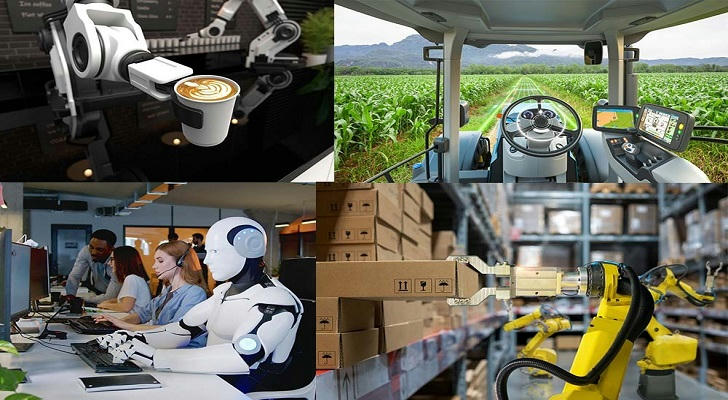AI and Automation how Vocational Training is Evolving
As artificial intelligence (AI) and automation reshape industries around the world, the demand for a new generation of skilled workers is growing rapidly. No longer confined to traditional tools and trades, vocational training programs are evolving to meet the needs of a tech-enabled future—preparing students for careers in robotics, CNC machining, advanced manufacturing, and automated systems.
In 2025 and beyond, vocational education is no longer just about plumbing and welding (though these are still in high demand). It’s about blending hands-on skill with high-tech know-how—making trade schools more relevant, future-focused, and essential than ever.

From Wrenches to Robots: The Shift in Skilled Trades
The industrial workplace has changed dramatically. Automated production lines, smart warehouses, and AI-powered logistics require workers who can operate, maintain, and troubleshoot complex machines. As a result, trade schools and vocational programs are shifting their curricula to include:
- Robotics operation and maintenance
- CNC (Computer Numerical Control) machining
- Programmable Logic Controllers (PLC)
- Industrial automation systems
- AI-based predictive maintenance and diagnostics
This evolution ensures that students are not only learning how to use a wrench, but also how to interface with digital diagnostics, read machine code, and keep robotic arms running smoothly.
1. Robotics Technician Training
Robots are becoming central to modern manufacturing, packaging, and logistics operations. From automotive assembly lines to Amazon’s fulfillment centers, robotics technicians are in high demand.
Modern Training Includes:
- Introduction to industrial robotics
- Robot programming (e.g., Fanuc, ABB, KUKA)
- Safety systems and protocols
- Sensor and actuator integration
- Troubleshooting robotic failures
Programs typically last 6–12 months and are offered by many community colleges and technical schools. These roles often start at $50,000–$70,000/year, with growth potential in automation engineering and systems design.
2. CNC Machining: The New-Age Fabrication
CNC machines have replaced traditional mills and lathes in many sectors. They require precision, coding, and maintenance—skills now taught at many vocational centers.
Key Skills Covered:
- G-code programming
- CAD/CAM software (like Fusion 360 or Mastercam)
- Machine calibration and tool path optimization
- Quality control using digital measurement tools
CNC machinists can earn $45,000–$65,000/year, and advanced certifications can unlock higher wages and supervisory roles. More importantly, automation hasn't reduced demand—it has transformed it. Skilled machinists now need both hands-on ability and digital fluency.
3. Smart HVAC and Electrical Systems
Heating, ventilation, and electrical systems are getting “smarter.” Modern HVAC units use AI sensors for energy efficiency, while smart home systems and commercial buildings rely on programmable components.
Vocational programs now teach:
- IoT-enabled HVAC controls
- AI-powered energy management
- Smart grid integration
- Solar and battery system maintenance
Graduates who understand how to install and repair tech-enhanced infrastructure are highly employable across residential, commercial, and green energy sectors.
4. Automation and PLC Programming
Factories run on Programmable Logic Controllers (PLCs)—the digital brains behind conveyor belts, robotic arms, and assembly lines. Trade schools are increasingly offering PLC-focused certification programs.
Training includes:
- Ladder logic and HMI interfaces
- Siemens, Allen-Bradley, and Mitsubishi platforms
- Troubleshooting and system diagnostics
- Integration with SCADA systems
This skillset is key in advanced manufacturing, logistics, food processing, and pharmaceuticals. Starting salaries often exceed $55,000, and automation experience can lead to high-level engineering and systems management careers.
5. AI Awareness and Digital Skills Across All Trades
Whether someone is studying to become a welder, a mechanic, or a heavy equipment operator, vocational programs are introducing AI and tech literacy into core training.
Courses increasingly include:
- Digital blueprint reading and 3D modeling
- Predictive maintenance using AI sensors
- Data input via tablets or mobile systems
- Remote troubleshooting and diagnostics
Even “traditional” trades are becoming high-tech. For example, welders now use augmented reality (AR) to practice their skills before working on live metal. Plumbers may use smart camera systems to diagnose leaks remotely.

Collaboration with Industry
To keep training relevant, trade schools are partnering with industry leaders like Siemens, Bosch, Fanuc, and Schneider Electric. These companies provide:
- Up-to-date machines and software
- Industry-certified instructors
- Internship and apprenticeship pipelines
Such collaboration ensures that students graduate with the exact tools and certifications employers want—creating a direct path to well-paying, high-tech careers.
Government Support and Funding
Governments in Canada, the U.S., and many EU countries are heavily investing in workforce development through:
- Reskilling grants and tuition subsidies
- Tax incentives for employers who hire skilled trades
- Infrastructure modernization projects that require automated systems
In many cases, eligible students can attend these programs for little or no cost, thanks to public funding for in-demand jobs.
Conclusion: The Future of Trades Is Smart
Vocational training in 2025 is no longer stuck in the past. It’s modern, tech-driven, and essential for the future workforce. With AI and automation transforming industries, trade schools are preparing a new generation of workers—not just to survive, but to thrive in a digital-first world.
If you’re looking for a career that combines stability, hands-on work, and cutting-edge technology, now is the time to explore vocational training in robotics, automation, and smart trades.
The trades aren’t dying—they’re evolving. And they need people like you.
